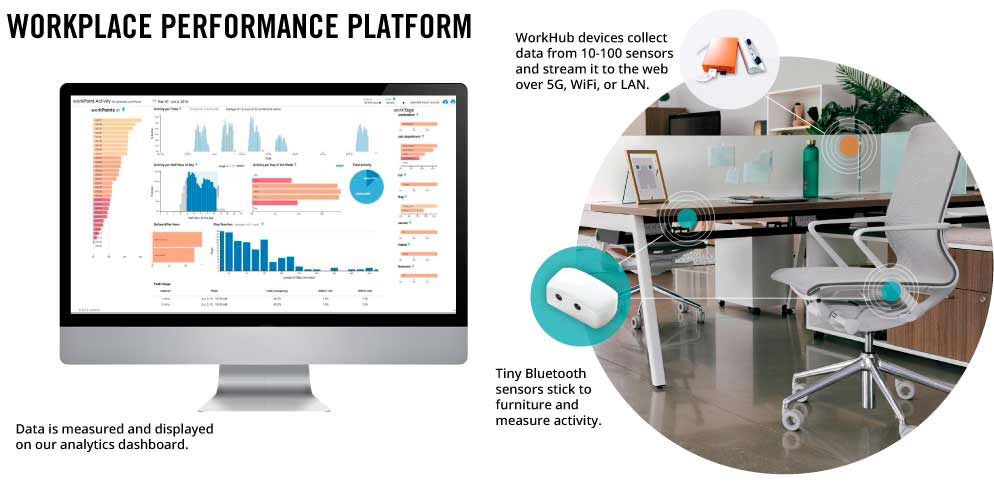Hybrid work is increasingly important to businesses and employees. While popular before 2020, in recent years it has become ubiquitous.
Employees see many advantages to hybrid work. It offers them increased flexibility, lower commute times, and improved work-life balance. It is also more environmentally sustainable. Many workers strongly prefer hybrid and remote options over traditional workplaces, and will continue to do so in the future.
It is crucial for employers to adopt data-driven strategies to ensure success in this new work environment. Successful hybrid workplaces gather and use high volumes of employee data, to make up for the lack of face-to-face interaction that traditional workplaces have.
This article will cover:
- Benefits of Data-driven Strategies
- Gathering Data from Workplace Analytics Tools
- Effective Use of Data: Analyzing Engagement, Productivity, and Collaboration
- Unisource Solutions’ Workplace Performance Platform
Manage and optimize occupancy with Hubstar Utilization
Benefits of Data-driven Strategies
Data-driven strategies can foster success among employees in a hybrid workplace by improving productivity, engagement, and collaboration. By collecting and analyzing the right data, managers can identify and address problems like burnout and poor use of resources.
With regards to productivity, a data-driven strategy helps identify bottlenecks and opportunities for reallocating resources such as computers or space. A good strategy will also collect information such as space utilization and the average time spent per task.
For employee engagement, a data-driven strategy can identify trends in attendance and time spent working. By analyzing chats, emails, and other in-office communications, analytics platforms can provide a sense of day-to-day employee sentiment, and discover what problems employees are really concerned about.
And as for collaboration, a data-driven strategy can help identify areas of overlapping work. It can also analyze communication patterns to determine where collaboration is being effective, and where it is not.
Let's also not forget about sustainability. Understanding workplace occupancy can also help reduce a company’s carbon footprint. Efficient use of resources means less waste. An incredible 39% of carbon emissions come from real estate. Smaller offices are more environmentally friendly, as are employees working from home.
Finally, an added benefit is the ability to manage timing. Data analysis can provide visibility to better inform decisions to decommission products at the right time, as well as storing furniture assets for future use.
Gathering Data from Workplace Analytics Tools
There are several types of useful data that can be collected from employees. Some of these include:
- Attendance
- Time spent working
- Utilization of space, furniture, and equipment
- Communication patterns
- Sentiment expressed through communication
The market for workplace analytics tools offers several tools, including ActivTrak, AnaPlan, IBM Planning Analytics, and Hubstar. Unisource Solutions has partnered with Hubstar to create our Workplace Performance Platform, with which you can track important metrics throughout your hybrid workplace.
Attendance is a basic, yet powerful, data point. It provides coarse information about employee engagement as well as space utilization.
Time spent working provides concrete information about productivity and engagement. More time spent working often translates into higher productivity. When it does not, this indicates that processes are inefficient.
Utilization of space, furniture, and equipment tells you what’s getting used, and how often. Optimally, everything in your workspace gets used on a regular basis, with a little extra room for flexibility. Underuse and overuse of space or equipment can imply employee engagement problems, or potential difficulties with collaboration.
Communication patterns indicate who is talking to whom, when they are talking, how often they are talking, and on what channels they are talking. This information provides hard data on your organization’s levels of engagement and collaboration.
Sentiment can be identified and understood through analyzing the content of intra-office communication. This can even be done anonymously, as analytics programs can provide aggregate sentiment information for an entire team. For example, you might be able to see a word cloud indicating the most commonly used emotional words by your team. Words like “tired” and “bored” are warning signs of problems like burnout.

Effective Use of Data: Analyzing Engagement, Productivity, and Collaboration
There are several key metrics that organizations can attempt to optimize to increase success. These are specific, measurable quantities that in some way indicate the state of productivity or proper functioning in the workplace. Some examples include:
- Average task completion time
- Collaboration levels
- Office space utilization
- Meeting participation
- Employee adoption rate
Effective use of data will identify patterns, trends, and areas of improvement in each of these domains.
Average task completion time gives a rough sense of how productive each employee is. Sudden changes in this metric can indicate employee problems, such as burnout. A decreasing average task completion time, on the other hand, may indicate improving productivity.
Collaboration levels can be measured by the amount of communication between teams or individuals through any particular channel, such as Slack or email. Low or infrequent rates of communication may indicate poor collaboration.
Office space utilization provides a sense of how well physical resources are being used within the organization. For example, if a room is constantly empty and unused, this could suggest the need for downsizing. On the other hand, if all rooms are always used, and there is even a waiting list for using space, this suggests that the workplace is in need of more or better allocation of space.
Meeting participation rates are excellent indicators of employee engagement and sentiment. Questions asked, points proposed, and even small factors such as having a camera on, all indicate an employee’s level of engagement in a meeting. In the aggregate, such data can provide insights on the engagement levels of entire teams.
Employee adoption rates indicate how fast and how often employees use new technology. It can sometimes be difficult to get employees on track with using new tools, especially if they are already adept at using old ones. Adoption rates tell you how effectively your resources are being used, and can be tracked easily without the need for external sensors.

Unisource Solutions' Workplace Performance Platform is a turnkey solution for optimizing hybrid workplaces
Unisource Solution’s Workplace Performance Platform
Our Workplace Performance Platform (WPP) is a comprehensive set of services designed to help companies unlock their workspace performance potential. The platform is driven by a strategic partnership with Hubstar, a leading workplace platform provider. It offers a powerful solution for data-driven strategies in the agile office.
The platform provides a variety of features which enable organizations to measure, predict, and optimize occupancy.
WPP provides organizations with a single source of truth for occupancy data. Hubstar’s patented algorithms accurately measure utilization, with or without sensors, and can predict occupancy based on historical patterns. The platform enables users to make high value decisions with an out-of-the-box set of metrics and intelligent suggestions.
WPP radically reduces hardware costs. Sensors can be useful, but are often too expensive to justify their cost. Instead, WPP can get an accurate picture of occupancy using just WiFi data, helping users make the right decision at the portfolio, zone, and floor levels. If you do have sensors, WPP can integrate that information with WiFi information to produce an extremely precise picture of occupancy.
WPP manages occupancy in real time. It provides intelligent consolidation suggestions and guidance on how many people you can accommodate.
Ultimately, our Workplace Performance Platform is a powerful workplace analytics tool that is tightly integrated into your organization to help you make the most informed decisions possible.
Key Takeaways: The Importance of Data-driven Strategies for Hybrid Working
Data-driven strategies are crucial in the era of hybrid work. In a time when the use of workspace resources is rapidly fluctuating, it’s more important than ever before to know how your organization is using its space, equipment, and personnel.
Having a well-designed plan for using your data can go a long way towards improving employee engagement, productivity, and collaboration. Through effective collection and analysis of metrics such as attendance and space utilization, organizations can make better decisions about their resources.
Hybrid work is not going away, and will most likely only continue to grow in importance in the years to come. This trend brings challenges and benefits to pursuing a data-driven strategy for your workspace. Some forms of data will become harder to track, while others will become easier to make use of.
In partnership with Hubstar, Univision Solutions offers a Workplace Performance Platform for effective management of your space. We believe that this is one of the most effective tools on the market for managing occupancy in real time with a single source of truth.
Let's Connect
Contact us to learn more about our how we help you optimize your hybrid workplace with a data-driven approach to improve employee engagement, productivity, and collaboration.







